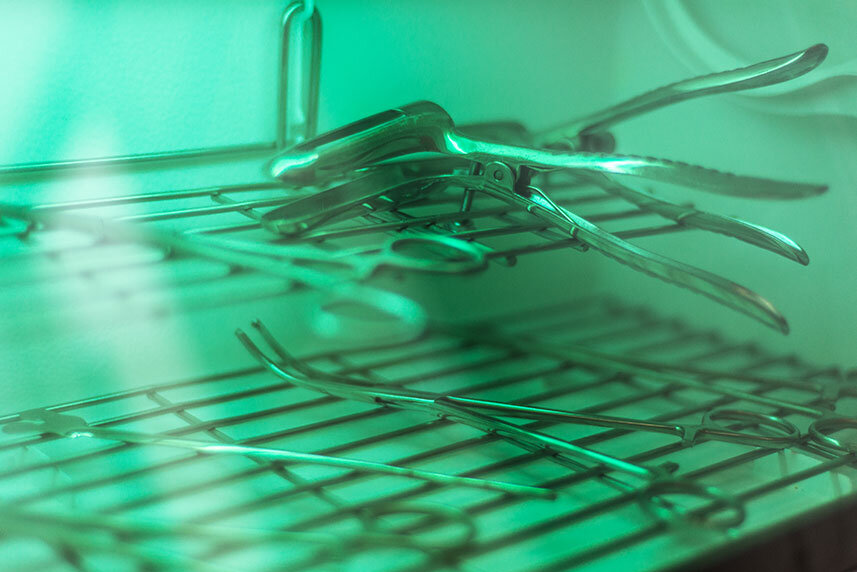When it comes to cleaning medical equipment, you need to take the proper precautions. Many people think that cleaning alone will ensure that your medical equipment is good enough to use. That’s not the case, especially regarding medical accessories and equipment. In addition to cleaning, you need to make sure that medical devices, medical equipment, and surgical instruments are properly disinfected and sterilized to the highest standards. Making sure that you are properly cleaning, disinfecting, and sterilizing will help keep your patients, employees, and environment safe and reduce the chances of healthcare-associated infections. With the highly infectious COVID-19 still infecting millions of people around the world, it’s never been more important to make sure you’re properly sterilizing your medical equipment in any healthcare facilities.
To get the most out of your sterilization process, you need to take three distinct steps: cleaning, disinfecting, and sterilizing.
1. Cleaning
Before doing anything, you have to make sure that you clean your medical equipment and the room that you intend to sterilize. Cleaning is always the first step in the sterilization process as it removes any excess dirt, debris, and fluid. Without cleaning, you’ll end up spreading around bacteria instead of removing them.
2. Disinfecting
The next step involves disinfecting the equipment and area. There are a number of different ways to disinfect equipment and any kind of medical device and the specific nature of disinfecting isn’t as important as the act of doing it. To make sure you get the most thorough disinfecting process possible, Bee Line Support has management complete a Certificate of Mastery in Infection Prevention in order to train all of our employees at surgical sites and medical offices. A CMIP certification allows us to train our employees to know how to take precautionary safety measures and infection prevention throughout all stages of disinfection and beyond. This means that your medical office is left in the cleanest conditions possible so that it’s safe for employees and patients.
3. Sterilizing
Finally, you need to sterilize the medical equipment, medical offices, and health care facilities. The sterilization process is done to kill disease-causing pathogens, bacteria, and viruses on the spot to eradicate the possibility of transmission. Sterilizing a surface, piece of medical equipment, or room gives you the confidence you need when treating patients and working with transmissible diseases.
In addition to reducing the number of HAIs that properly sterilizing your medical equipment brings, there are a number of other benefits. Since medical equipment is used frequently in invasive procedures, you significantly reduce the risk of surgical procedures and lower the possibility that pathogens, bacteria, viruses, and other microbes will infect the surgical area. This reduces the risk of infection and helps doctors and surgeons take the best care of their patients possible. Properly sterilizing medical equipment eliminates any traces of blood, harmful pathogens, dirt, or other bodily fluids from equipment, thus creating a safer environment. It also keeps equipment in good condition for as long as possible by preventing corrosion and rust. Sterilization is the only way to eliminate the germs that allow pathogens to breed and cross-contaminate your medical office.
To get the most out of the benefits of sterilizing your medical equipment, make sure that you determine what kind of sterilization you need based on the object’s intended use. Surgical objects and instruments need other sterilization methods such as high-level sterilization while stethoscopes need low temperature sterilization. For the most comprehensive clean, make sure that you hire a professional cleaning company like Bee Line Support. We’re one of the only cleaning companies to use Black Light auditing to make sure that no surface is left untouched. We’re also a proud partner with ImageFIRST, meaning we have a strict process for cleaning and managing supplies. This process is unique, yet effective. It guarantees that supplies are 99.9% clean of common pathogens, exceeding OSHA and CDC standards, and complying with Joint Commission requirements.
Different Sterilization Methods
How you sterilize your equipment depends largely on what type of equipment you’re using and what it’s come in contact with. If you use inadequate sterilization processes or perform them poorly, you won’t kill the bacteria, pathogens, microbes, and viruses on the surfaces. The following methods of sterilization are used to help make sure you’re doing everything in your power to keep your patients and employees safe.
-
Dry Heat Sterilization – This method requires a longer time commitment and should only be performed on heat-resistant materials. You will expose the materials to extremely high temperatures (above 300 degrees Fahrenheit) for an elongated period of time so that all of the pathogens and microbial life on the surface are destroyed.
-
Chemical Sterilization – Using an array of chemicals like ethylene oxide, hydrogen peroxide, and bleach, chemical sterilization works to kill pathogens on contact. For this to be effective, the equipment has to be submerged in a solution for a period of time so that the pathogens die. After sterilization, the equipment should be rinsed off and given time to adequately dry.
-
Steam Sterilization – This is a popular method of sterilization and is one of the most common options for medical equipment sterilization. After applying the decontaminant, highly heated water particles are applied at increasing pressures to thoroughly sterilize the equipment.
-
Plasma Gas Sterilization – This is less common, but most similar to steam sterilization. A plasma gas made up of hydrogen peroxide is used inside of a chamber to sterilize the necessary equipment. This method is fairly expensive and requires special equipment.
-
Vaporized Hydrogen Peroxide (VHP) Sterilization – This method also uses hydrogen peroxide vapor without the plasma gas. The vapors inside of the enclosure works to sterilize the equipment and has a higher sterilization capacity due to the time it takes to successfully process.
Bee Line Support was incorporated in 1997 and is a woman-owned company certified as a Woman Business Enterprise (WBE) by the Women’s Business Enterprise National Council. To prepare all of our employees for excellence, we’ve built a medical exam training suite and bathroom to conduct mock cleaning simulations, educate staff on high touch points, test management, demonstrate proper personal protective equipment use, and train staff on full medical facility cleaning protocol. Bee Line Support is committed to helping your medical office stay clean.
Bee Line Support always uses state-of-the-art HEPA filter vacuums, Green Seal-certified disinfectants, and microfiber towels to eliminate bacteria and viruses completely. Bee Line Support also offers upholstery-cleaning services, carpet cleaning services, vacuuming, garbage removal, and comprehensive janitorial services to make sure that no pathogens are missed in your medical office. To make sure that no spot goes un-cleaned, Bee Line Support uses quality control cleaning, routine management inspections, and continual onsite training for our employees.
Call Bee Line Support at 312-BEE-LINE or message us today to have your medical office cleaned, disinfected, and sterilized today.
About The Author
Jesse Parra
author
It’s hard to find a more reliable manager than Jesse. When it comes to your needs, concerns, and questions, you can count on Jesse to help you out. Jesse is a native to Chicago and is a proud pet parent to his chihuahua named Peter. In his spare time, you can find Jesse practicing his photography skills, cheering on the Cubbies, and seeking out the best taco joints in town! His favorite aspect of working with Bee Line is the incredible teamwork, his friendly coworkers, and the many opportunities for growth.



